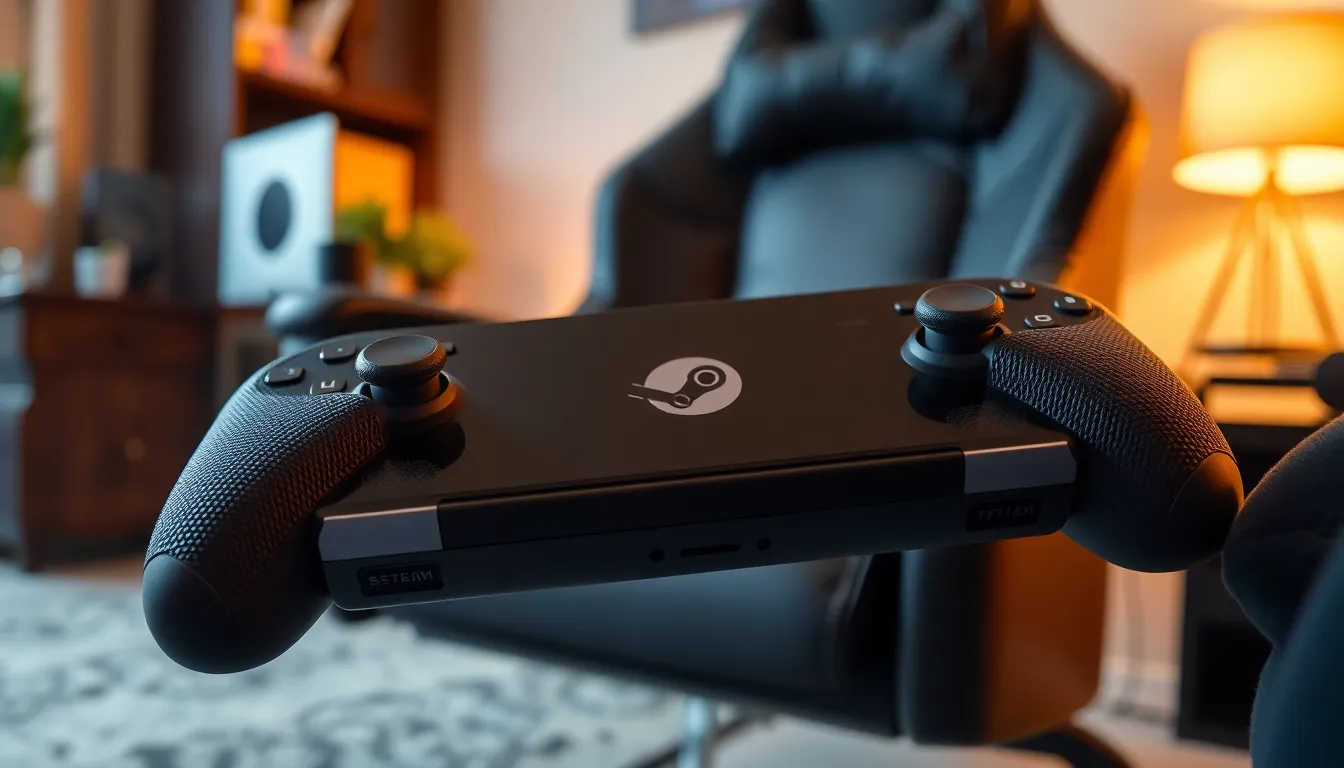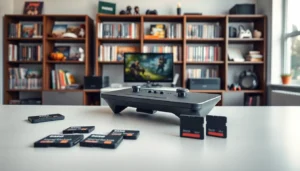Table of Contents
ToggleThe Steam Deck has landed, and it’s shaking up the gaming world like a toddler with a sugar rush. Imagine cramming the power of a gaming PC into a handheld device that fits snugly in your backpack. It’s not just a gaming console; it’s a portable powerhouse that promises to redefine how players experience their favorite titles on the go.
From the moment it powers on, the Steam Deck invites gamers into a world where high-end graphics and smooth gameplay are just a thumb’s swipe away. But does it live up to the hype? With its unique design and impressive specs, this little gadget has gamers buzzing with excitement and maybe a little confusion. Let’s dive into the first impressions of the Steam Deck and see if it’s the game-changer everyone’s been waiting for or just another shiny toy collecting dust.
Overview of Steam Deck
Steam Deck serves as a handheld gaming device that merges the capabilities of a gaming PC with convenient portability. Designed by Valve, it boasts a custom AMD APU, which ensures high performance for various games. The device features a 7-inch touchscreen display with a resolution of 1280 x 800 pixels, providing crisp visuals for an immersive gaming experience.
Ergonomic controls enhance gameplay comfort, including thumbsticks, a D-pad, and a trackpad. Gamers can access their entire Steam library, which includes thousands of titles. The Steam Deck supports multiple control schemes, accommodating both casual and hardcore gamers.
Battery life varies depending on usage, ranging from two to eight hours. Users can find it beneficial to manage performance settings to optimize playtime. The device operates on a customized SteamOS, allowing seamless navigation and easy access to gaming features.
Storage options include 64GB eMMC, 256GB NVMe SSD, and 512GB NVMe SSD, ensuring plenty of space for downloads and installations. Expandable storage through a microSD card slot adds flexibility for gamers with large libraries.
Connectivity options feature Bluetooth, Wi-Fi, and USB-C, facilitating connections to various peripherals. The Steam Deck also offers a dock for a more traditional console experience when connected to a TV or monitor.
Overall, Steam Deck aims to deliver high-end gaming while maintaining the convenience of a portable console. It invites existing and new gamers to experience library access and advanced features in a handheld format.
Design and Build Quality

The Steam Deck features a thoughtful design that prioritizes both functionality and comfort. Its layout caters to gamers who demand performance and ease during long play sessions.
Ergonomics
Ergonomic design plays a significant role in the Steam Deck’s popularity. Controllers rest comfortably in hand, allowing for extended gameplay without discomfort. Device weight balances evenly for a stable grip, reducing fatigue. Button placements accommodate various hand sizes, ensuring accessibility for all users. Thumbsticks and triggers respond with precision, enhancing the gaming experience. Users can enjoy hours of gameplay without strain, a crucial aspect for many dedicated gamers.
Materials Used
Durability is key in the selection of materials for the Steam Deck. The casing utilizes high-quality plastic, providing a sturdy feel while remaining lightweight. Grippy textures on the handles offer reliable control during intense gaming sessions. Screen protection comes from tempered glass, helping prevent scratches and damage. Each component includes attention to detail, reflecting Valve’s commitment to quality. This combination of materials contributes to an overall robust device, ready for various gaming environments.
Performance Experience
The Steam Deck delivers an impressive performance tailored for gaming on the go. Gamers experience high-quality graphics and fast load times, thanks to its custom AMD APU.
Gameplay Performance
Gameplay performance impresses with smooth frame rates across various titles. Users report fluid gameplay in games like “Apex Legends” and “The Witcher 3.” This handheld device can handle demanding AAA games as well as indie titles, making it versatile. Frame rates average between 30 to 60 FPS depending on game settings. Players customize graphical settings to optimize performance without sacrificing visual fidelity.
Battery Life
Battery life varies significantly based on usage, showcasing flexibility. Under intensive gaming, it lasts around two hours, while lighter tasks can stretch it to eight hours. Users can expect around four hours for moderate gaming experiences, balancing performance and efficiency. Power settings can be adjusted to extend battery life, enhancing overall convenience. Gamers often appreciate this adaptability, allowing them to enjoy extended play sessions without frequent recharges.
Software and User Interface
The Steam Deck features a user-friendly interface designed for seamless access to games and settings. It operates on a customized version of SteamOS that offers a variety of useful functionalities.
Operating System
SteamOS 3.0 powers the Steam Deck, providing a gaming-centric environment optimized for performance. Users experience fast boot times and smooth navigation through the system’s intuitive menu. Notably, the operating system supports a multitude of Steam features like game libraries, community tools, and store browsing. Gamers can also install third-party applications, enhancing the versatility of the device. Built-in Steam features, including remote play and cloud saves, make it easy to switch between devices and continue gaming without interruptions.
Game Library Access
Accessing the Steam library on the Steam Deck is a straightforward process. Gamers can dive into their extensive collection of thousands of titles from the moment they power on the device. Compatibility with most Steam games ensures users can enjoy a wide range of genres, including AAA releases and indie gems. Game performance often depends on the individual title, with many reported to run smoothly even at higher settings. Valve’s continuous updates and community feedback contribute to improving the overall experience, keeping the library relevant and engaging.
Controller and Input
The Steam Deck offers a well-thought-out control scheme that caters to various gaming preferences.
Button Layout
The button layout features an arrangement that combines efficiency and comfort. Four face buttons sit alongside dual analog sticks, ensuring precise control. Additionally, the D-pad maintains a firm and responsive feeling while allowing for quick inputs. Users can access four customizable rear buttons, enhancing gameplay by providing easy shortcuts to in-game actions. This extensive configuration enables users to tailor their experience, facilitating both casual and competitive gaming sessions. Overall, the Steam Deck’s button layout successfully meets the needs of diverse gaming styles.
Touchscreen Functionality
Touchscreen functionality enhances the user experience by providing an intuitive interface. The 7-inch display supports direct interaction, allowing users to navigate menus with ease. Gamers can swipe through their libraries or adjust settings without relying solely on physical buttons. This feature proves particularly useful when accessing complex menus or browsing the Steam store. Moreover, touchscreen support simplifies the setup of third-party apps, making it easier to customize the Steam Deck further. The combination of touchscreen capabilities and traditional inputs creates a versatile gaming environment, appealing to different user preferences.
The Steam Deck represents a significant step forward in portable gaming. With its robust performance and thoughtful design it caters to a wide range of gamers. The combination of powerful hardware and an extensive library makes it a compelling choice for anyone looking to game on the go.
Ergonomics and build quality enhance the overall experience ensuring comfort during long sessions. Valve’s commitment to continuous improvement through software updates further solidifies its potential in the gaming market. As it stands the Steam Deck is not just another gadget but a serious contender in the handheld gaming space.







